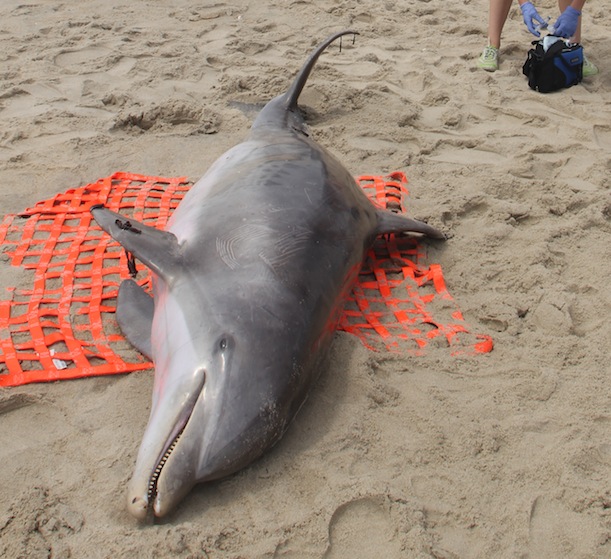Why Are So Many Dolphins Washing Up Dead on the East Coast?
A Smithsonian marine biologist investigates the sudden die-off of bottlenose dolphins along the Atlantic—and suspects that human activity may play a role
Scientists are analyzing the dozens of dolphins suddenly washing ashore to learn more about their deaths. Image via Virginia Aquarium & Marine Science Center
Last month, alarming numbers of dead bottlenose dolphins started turning up on the beaches of Virginia and other states in the Mid-Atlantic region. In an average July, the Virginia Aquarium & Marine Science Center—which operates a Stranding Response Team to collect and analyze beached animals—encounters seven dolphins washed ashore. In July 2013, the team picked up 44 animals.
Overall, the East Coast has seen at least 124 dolphin deaths since July—a rate that authorities say is seven times higher than normal. All of this led the National Marine Fisheries Service, a branch of the NOAA, to officially designate the deaths as an “unusual mortality event” last week, which means that increased federal funds will be allotted to help researchers investigate what’s going on.
Currently, dozens of marine biologists along the Atlantic are examining stranded dolphin carcasses for clues. Last week, Charles Potter, a marine mammal expert with the Smithsonian Natural History Museum, traveled to Virginia Beach to assist with the Virginia Aquarium & Marine Science Center’s investigation.
“We basically perform necropsies of the carcasses that come in,” Potter says. “We’re assuming nothing, and looking at the entire animal for the cause of death, and any abnormal tissues. We also harvest a whole suite of specimens from each carcass, and these are sent out to labs for analysis.” During his time in Virginia Beach, he conducted five in-depth necropsies—animal autopsies—in total.

Charles Potter (in orange) works with Megan Arnold (holding camera) and Erin Bates of Virginia Aquarium to study a beached dolphin. Image via Virginia Aquarium & Marine Science Center
The investigation is still in its earliest stages, but researchers have a few potential suspects in mind. In 1987—when the last major die-off of Atlantic dolphins occurred, resulting in the deaths of 740 animals—morbilivirus was found to be the main culprit. At least one dolphin found this year has tested positive for the same virus, which produces lesions in the lungs and central nervous system tissue, and Potter speculates that the time that’s passed since the previous epidemic has allowed for a generation of dolphins never exposed to the pathogen.
But establishing a potential cause of the die-off as a whole is much harder than diagnosing a particular cause of death for any one individual. With humans, if you ask someone in the hospital what a specific patient died from, you may be told that the person had pneumonia, explains Potter, who also participated in the 1987 investigation. “But that’s only because we become so debilitated by other factors that, at some point, we can’t clear our airways, and we develop these pneumonia infections,” he says. In much the same way, it’s possible that a susceptibility to morbilivirus or other pathogens found in the dolphins could be caused by a separate, underlying factor.
That underlying factor might be a particularly disconcerting one: humans. Disproportionate numbers of males and calves are among the dolphins turning up dead, which makes Potter and other suspicious that environmental contaminants—such as heavy metals, pesticides and hydrocarbons—might play a role.
“Males don’t have a mechanism for shedding contaminants,” he says. “The females shed significant amounts of their lipid-soluble contaminants through lactation, so the calf gets a hell of a dose early on in life, and some of the most outrageous levels of contaminants we’ve seen have been in calves.” It’s possible that the overall buildup of contaminants in these animals—along with other stresses attributable to human activity, such as increased noise and competition for space and food with humans—is making them more susceptible to infectious pathogens.
Potter says that he and other investigators will continue testing the dolphins for the virus, contaminants and other factors so they can try to find further clues to solve the mystery. Getting the animals in a fresh condition is crucial to collecting as much useful information as possible. “All too often, the response team will go out and pick up a carcass and will hear that it was first seen the night before, so by 9 o’clock in the morning, it’s been lying out there since sunup, and we’ve lost a tremendous amount of data,” he says. “As soon as someone sees a dolphin, whether dead on the beach or in distress, they need to call it in to the authorities immediately.”
The NOAA operates a Stranding and Entanglement Hotline for all marine life. If you find a dolphin, they recommend staying away from it and calling the hotline at 1-866-755-6622.
/https://tf-cmsv2-smithsonianmag-media.s3.amazonaws.com/accounts/headshot/joseph-stromberg-240.jpg)

/https://tf-cmsv2-smithsonianmag-media.s3.amazonaws.com/accounts/headshot/joseph-stromberg-240.jpg)